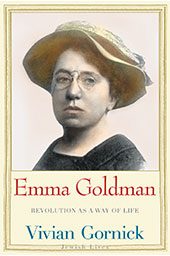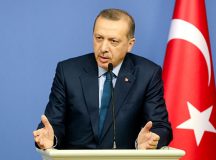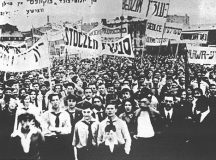The inclusion of the anarchist Emma Goldman in the Yale University Press Jewish Lives series is to be welcomed. Immigrating to New York from Russia in 1885, Goldman was a celebrity in her own time; an activist, editor, formidable public speaker and writer. She was a conspicuously modern figure as much at home in debating modernist drama as in political anarchy. Her radicalisation came through her immersion as a young immigrant in the Yiddish-speaking anarchist communities of New York’s Lower East Side. Though this remained her heritage, she did not want to be confined to being a specifically Jewish activist. The rise of European anti-Semitism made her think again about Jewishness, but she was never a Zionist. After all, how could a capitalist state liberate Jews? However, she fully supported the right of Jewish people to settle in Palestine to work and to flourish as a people.
Goldman led an incredibly packed life, driven by unbending and incorruptible commitment. She did her time in sweatshops and prisons, and was active in America, Russia and Spain, as well as working as a nurse, running her own magazine and earning a living through lecture tours. Gornick decided to ‘concentrate on her [Goldman’s] extraordinary rebelliousness and try to understand it in the light of the existential drive behind radical politics.’ The book is in three sections, each corresponding to a phase of Goldman’s life. The first, Temperament, explores some of the roots of her enthusiasm. For Gornick, the driving force behind Goldman was a wild, exuberant passion for a multiplicity of causes: social justice, the complete liberation of the individual and her own existential need to rebel. This drew her into anarchism as a ‘protean experience’ as much as a doctrine. Enraged by the execution of the patently innocent Chicago Martyrs in 1887, she became gripped by the idea of carrying out an act of revolutionary violence and was an accessory to the attempted murder of Henry Clay Frick, the manager of the Carnegie Steel Plant in Homestead Pennsylvania, by her close companion Alexander (Sasha) Berkman. Berkman served a long prison sentence; Goldman’s escape from prosecution enabled her to set out on an intellectual journey that led her away from ‘propaganda by deed.’
This journey forms the second section of the book. It was the hostile reaction to the attempt on Frick’s life that caused Goldman to think again about the utility of violence. She saw how counter-productive it was and now condemned the act, but not the perpetrator. For her, the ultimate responsibility lay with the injustices of society; righteous rage would always drive someone to take drastic action. And, after all, how could she denounce her beloved Sasha?
Gornick puts part of this change down to Goldman’s trip to Europe and the influence of Peter Kropotkin, who she describes as a ‘gentle theorist’ devoted to ‘education rather than insurrection.’ In doing so, Gornick repeats a common misreading. Kropotkin may have developed the theory of mutual aid, but he was a revolutionary. In fact, all the anarchist movement was distancing itself from individual acts of violence, using similar arguments. What is more, Kropotkin fell out with Goldman and others over the First World War. Kropotkin supported the war against Germany, whilst Goldman was an anti-war activist, something that led to her expulsion from the United States, her home for more than thirty years. Her bitter exile is the theme of the third section.
The picture of Goldman that has emerged so far is someone who would sit comfortably within the confines of the modern left; the cause of terrorism is rage at injustice; war is an act of imperialism to be opposed unconditionally. Nor was she particularly original within the anarchist movement, where most espoused ‘free love’ and feminism. The main division between individualist and communist anarchism was over political economy and Goldman remained in the communist camp, accepting the idea of class struggle. Yet she took a great interest in existential individualism and the work of writers like Stirner and Nietzsche, pointing to an independence of mind that was to lead her into a new and critical phase of her life.
Goldman’s exile began as a result of a spasm of authoritarian moral panic in the USA. Convicted with Berkman of sedition in 1917, both were deported on their release from prison in 1919 to their country of birth, Russia. However painful exile was, Bolshevik Russia embodied the hopes of a generation of socialists and revolutionaries. It was the world made anew. It had the support of all the left. Goldman and Berkman were no exception. Two years later, they got out just in time having decided that the Bolsheviks were counter-revolutionaries who had seized power, halted a popular revolution and were now imposing a new tyranny.
Goldman’s memoir, My Two Years in Russia earned her the hostility of the left who clung to their illusions. Even Gornick has some difficulties with it. She thinks that Goldman’s analysis of the young revolutionary state was ‘overwhelmingly negative – a black-and-white depiction of what was still only a revolution in trouble, not yet a fully formed totalitarian state.’ She passes on Alice Wexler’s claim that Goldman helped ‘lay the foundations of a caricature of Russian history that served interests profoundly hostile to her own.’ In fact, Goldman spoke out against the Red Terror, the suppression of the Kronstadt rising, the arrest and persecution of her old comrades, the policy of War Communism, and the consequent catastrophic famine of 1921, precisely to keep alive the dream of a genuine popular revolution; she should be regarded as the founder of the anti-communist left. Orwell might be the most celebrated, but Goldman was the instigator and was followed during the Cold War by the likes of Max Shachtman and Dwight Macdonald. Her direct experience and mental honesty led her to confront the apologism and self-delusions of the left to which she still belonged.
Gornick thinks that what drove Goldman ‘wasn’t intellect, it was a depth of spirit – unaltered, unyielding, uncompromised.’ This was also true of her personal life. Gornick writes despairingly of Goldman’s sexual passions and her inability to square her own jealousies and infatuations with her theories. But I see another passion in Goldman, one that was an inheritance from her Jewish immigrant experience: the passion for learning. She was a formidable autodidact and when faced with political realities, she became coolly analytical. As her intellect and experience collided, they produced ethics: ‘The whole history of man is continuous proof of the maxim that to divest one’s methods of ethical concepts means to sink into the depths of utter demoralisation,’ she wrote.
Without an ethical commitment to all humanity, there can be no liberation. That is her lasting epitaph, perhaps. It is no mean guide to dealing with the continuing struggles of the 21st century.





































